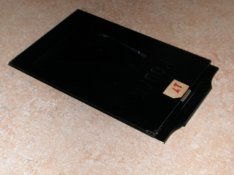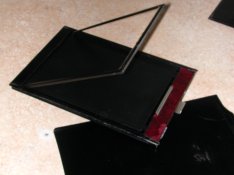Dang blew it...
Note the horizontal emulsion lift... finished development and all was well, then placed plate in a small glass tray, that we had filled with a little distilled water and added several drops of photo flow, and it let sit in there as we cleaned up.
So what could have caused this?
Here's the suspects lined up..
1) Distilled water was not the within the temp of 65-68 degrees. Could have been 75 to 80 degrees. To hot, and to much of a temperature change and emulsion surrendered.
2) Da read the bottle of photo flow afterwards.. Mix 1 part to 200 parts of water. Didn't do that, would to a strong solution of Photo Flow cause this?
3) Left it to long in Photo Flow as we cleaned up.. maybe 3 to 5 minutes..
4) or .. All of the above... and guilty as charged.
BTW.. Shot in a Anniversary Speed 3x4, Early morning sun, 2 Asa .. f 11 @ 1sec.. about 1/2sec more exposure than meter called for, but could use the speed setting on the shutter.
Edit; we focused from the ground glass, on the knife at her waste, but looking at the scan, that's not in focus, the truck behind is!. So the offset of the Adapter must be throwing the focus off, as the cardboard insert that held the film is not there.
Shot using a 3x4 Film Pack Adapter, with a 9x12 dry plate inserted within, with black mat board and foam for pressure against its back and to light seal. Small light leak at the bottom left corner can be seen in the image.
The Film Pack Adapter has no name on it and is larger than the other Grafhic Film Pack Adapter Cat # 1233, from my old dads stuff, which interior is to narrow to take a 9x12 glass plate.
The rest of the story is the unnamed Adapter, had been modified at some time in the past, perhaps by my dad, who knows, with thin ribs of felt, glued to the metal, that allowed the 9x12 plate to fit exactly within its boundaries. Interesting!





